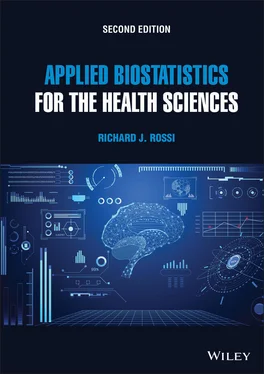Richard J. Rossi - Applied Biostatistics for the Health Sciences
Здесь есть возможность читать онлайн «Richard J. Rossi - Applied Biostatistics for the Health Sciences» — ознакомительный отрывок электронной книги совершенно бесплатно, а после прочтения отрывка купить полную версию. В некоторых случаях можно слушать аудио, скачать через торрент в формате fb2 и присутствует краткое содержание. Жанр: unrecognised, на английском языке. Описание произведения, (предисловие) а так же отзывы посетителей доступны на портале библиотеки ЛибКат.
- Название:Applied Biostatistics for the Health Sciences
- Автор:
- Жанр:
- Год:неизвестен
- ISBN:нет данных
- Рейтинг книги:3 / 5. Голосов: 1
-
Избранное:Добавить в избранное
- Отзывы:
-
Ваша оценка:
- 60
- 1
- 2
- 3
- 4
- 5
Applied Biostatistics for the Health Sciences: краткое содержание, описание и аннотация
Предлагаем к чтению аннотацию, описание, краткое содержание или предисловие (зависит от того, что написал сам автор книги «Applied Biostatistics for the Health Sciences»). Если вы не нашли необходимую информацию о книге — напишите в комментариях, мы постараемся отыскать её.
APPLIED BIOSTATISTICS FOR THE HEALTH SCIENCES Applied Biostatistics for the Health Sciences
Applied Biostatistics for the Health Sciences
Applied Biostatistics for the Health Sciences — читать онлайн ознакомительный отрывок
Ниже представлен текст книги, разбитый по страницам. Система сохранения места последней прочитанной страницы, позволяет с удобством читать онлайн бесплатно книгу «Applied Biostatistics for the Health Sciences», без необходимости каждый раз заново искать на чём Вы остановились. Поставьте закладку, и сможете в любой момент перейти на страницу, на которой закончили чтение.
Интервал:
Закладка:
3 c. Because the medical researcher could assign the subjects to these two treatments, it could be performed as an experiment.
An important advantage experiments have over observational studies is that it is possible in an experiment to control for external factors that might cause differences between the units of the target population. By controlling for the external factors in an experiment, it is possible to make the groups of units assigned to different treatments (i.e., treatment groups) as alike as possible before the treatments are applied. Moreover, in a well-designed experiment when the value of an explanatory variable is changed while no other changes take place in the experimental conditions, any differences in the responses are most likely due to the change in the value of this explanatory variable.
On the other hand, it is much harder to control external factors in an observational study because the units come to the researcher already assigned to the treatments, and thus, in an observational study there is no guarantee that the treatment groups were alike before the treatments were assigned to the units. Because experiments can be designed to control external factors, they can be used to establish evidence of causal relationships; an observational study generally cannot provide strong evidence of a causal relationship because uncontrolled external factors cannot be ruled out as the potential cause of the results.
Example 1.9
To study whether echinacea is effective in shortening the duration of the common cold, a random sample of 200 volunteers is taken. The 200 subjects are divided into two groups of size 100. Each group gets a supply of 300 mg pills and is instructed to take a 300 mg pill as soon as they recognize cold symptoms and to continue taking a pill each day until their cold symptoms go away. One group will receive 300 mg echinacea pills and the other group 300 mg placebo pills. The subjects are asked to record the duration of each cold they have in the following year.
1 Is this study an experiment or an observational study?
2 What is the target population in this study?
3 What is the response variable in this study?
4 What are the treatments in this study?
5 Is this a prospective or retrospective study?
Solutions
1 This study is an experiment because the researcher assigned the subjects to the treatments.
2 The target population in this study is people having the common cold.
3 The response variable in this study is the duration of the common cold.
4 The treatments in this study are 300 mg echinacea and 300 mg placebo.
5 This is a prospective study because the subjects are being followed forward in time.
Example 1.10
To study whether or not there is a relationship between childhood obesity and parental obesity in the United States, a random sample of 500 families was selected. The parents and children in each family were then classified as normal weight, overweight, or obese. The goal was to compare the percentage in each of the weight classifications of the children with normal weight parents against the percentages of the children with overweight and obese parents.
1 Is this study an experiment or an observational study?
2 What is the target population in this study?
3 What is the response variable in this study?
4 What are the treatments in this study?
Solutions
1 This study is an observational study because the subjects came to the researcher assigned to their respective weight classifications.
2 The target population in this study is parents with children living in the United States.
3 The response variable in this study is weight classification of a child. The weight classification of the parent is an explanatory variable.
4 The treatments in this study consist of weight classifications of the parents (normal, overweight, or obese).
1.3 Clinical Trials
Clinical trials are generally associated with biomedical research studies that are carried out on people for testing how well a new medical approach works, for testing the efficacy and safety of new drugs, for evaluating new biomedical procedures or technological advances, and for diagnosing, treating, managing, or preventing a disease. In the United States, a clinical trial is often highly regulated to ensure that it follows a well-designed research protocol that is ethical and preserves the safety of the participants.
For example, in the development of a new drug, a pharmaceutical company often begins by testing the drug on human cells and animals in a laboratory setting. If the initial laboratory research indicates that the drug may be beneficial to humans, the next step is to submit a new drug application (NDA) to the FDA. The NDA will contain information on the drug, the results of all prior test data on the drug, and descriptions of the manufacturing process used to make the drug. The FDA will then determine whether the drug is safe and effective for its proposed use(s), whether the benefits of the drug outweigh its risks, whether the drug’s proposed labeling is appropriate, and, if not, what the drug’s appropriate labeling is, and whether the methods used in manufacturing the drug and the controls used to maintain the drug’s quality are adequate to preserve the drug’s identity, strength, quality, and purity. Supervised clinical trials represent the final testing ground for a new drug, and the results of the clinical trials will be used in the final approval or disapproval of a new drug.
1.3.1 Safety and Ethical Considerations in a Clinical Trial
Every well-designed clinical trial will have a predetermined research protocol that outlines exactly how the clinical trial will be conducted. The clinical trial protocol will describe what will be done in the trial, the rules for determining who can participate, the specific research questions being investigated, the schedule of tests, procedures, medications, and dosages used in the trial, and the length of the trial. During the clinical trial, the participants are closely monitored by the research staff to determine the safety and effectiveness of their treatment. In fact, the ethical treatment and safety of the participants are carefully controlled in clinical trials performed in the United States.
In general, a clinical trial run in the United States must be preapproved by an independent committee of physicians, biostatisticians, and members of the community, which makes sure that the risks to the participants in the study are small and are worth the potential benefits of the new drug or treatment. Many, if not most, externally funded or university-based clinical trials must be reviewed and approved by an Institutional Review Board (IRB) associated with the funding agency. The IRB has the power to decide how often to review the clinical trial, and once started whether the clinical trial should continue as initially planned or modifications need to be made to the research protocol. Furthermore, the IRB may end a clinical trial when a researcher is not following the prescribed protocol, the trial is unsafe, or there is clear and strong evidence that the new drug or treatment is effective.
1.3.2 Types of Clinical Trials
Clinical trials can generally be classified as one of the following types of trials:
Treatment trials that are clinical trials designed to test experimental treatments, new drugs, or new medical approaches or technology.
Prevention trials that are clinical trials designed to investigate ways to prevent diseases or prevent the recurrence of a disease.
Screening trials that are clinical trials designed to determine the best way to detect certain diseases or health conditions early on.
Читать дальшеИнтервал:
Закладка:
Похожие книги на «Applied Biostatistics for the Health Sciences»
Представляем Вашему вниманию похожие книги на «Applied Biostatistics for the Health Sciences» списком для выбора. Мы отобрали схожую по названию и смыслу литературу в надежде предоставить читателям больше вариантов отыскать новые, интересные, ещё непрочитанные произведения.
Обсуждение, отзывы о книге «Applied Biostatistics for the Health Sciences» и просто собственные мнения читателей. Оставьте ваши комментарии, напишите, что Вы думаете о произведении, его смысле или главных героях. Укажите что конкретно понравилось, а что нет, и почему Вы так считаете.












